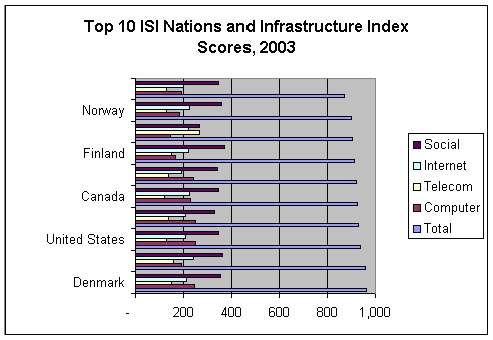 Denmark appears as the top ranking nation in IDCs Information Society Index (ISI), a study that combines 15 variables in four infrastructure pillars to calculate and rank 53 nations ability to access and utilize information and information technology.
Denmark appears as the top ranking nation in IDCs Information Society Index (ISI), a study that combines 15 variables in four infrastructure pillars to calculate and rank 53 nations ability to access and utilize information and information technology.
For the first time in four years, Sweden has been displaced from the number 1 position. In parallel , the U.S., Switzerland and Canada displaced the Netherlands, Norway, and Finland to round out the top 5.
IDC points that in much the same way that gross domestic product (GDP) measures a countrys economic wealth, the ISI measures its information capacity and wealth. Its four pillars are:
· Computers This pillar looks at the basic building blocks of information society by measuring the number of PC households, IT spending as a percentage of GDP, software spending as a percentage of total IT spending, and IT services spending weighted against GDP.
· Internet The Internet is a key factor in the development of an advanced information society. This pillar factors in the number of Internet users within a country, the percentage of users with Internet access at home, the number of mobile Internet users, and ecommerce spending.
· Telecoms To better understand how each society accesses information, this pillar measures variables related to broadband adoption, wireless services, and mobile handset shipments.
· Social Social factors provide the glue that enables society to fix onto the advantages offered by innovation. This pillar evaluates a societys ability to utilize information technology by measuring education, civil liberties, and government corruption.
Typically, we have seen that the civil liberties and education levels of a nation strongly determine its level of technology adoption, but there seems to be a loophole where wireless adoption is concerned, noted David Emberley, senior analyst for the IDC Worldwide IT Markets and Strategies research portfolio. This is one area in which consumer adoption has been strong even in some of those countries with lower overall scores for social freedoms.
At the top of the rankings, Denmark received high scores in a number of variables across all four pillars. Based on 2003 data, 67% of the population in Denmark is accessing the Internet with 84% of those users connecting from home. 22% of the households are using broadband connections while total mobile subscriber penetration in Denmark reached 59%.
In comparison with the U.S., Denmark ranks higher primarily due to a lead in the telecom variable, notably wireless subscribers as well as in Internet where Denmark jumped ahead in both user penetration and mobile Internet users. However, the U.S. scored highest for computers based on PC’s per household and software spending, thus continuing to hold its position as the world’s largest consumer of computer products and services.

Source: IDC, 2004
At the bottom of the rankings were the less-developed Information Societies countries where there is far less ability to access and use information and information technology. Of the 53 countries profiled in IDCs Information Society Index, Indonesia, Vietnam, India and Turkey received the lowest overall scores. It should be noted, however, that these scores are based on a profile of each country as a whole. In addition, the study only examined those countries where IDC has a substantial local research presence, representing the 53 largest IT markets in the world. It is incorrect to interpret the Index as a statement that these countries have the worlds least developed Information Societies or are among the worlds least developed countries.
For more specific detail on each country, go to www.idc.com/ISI2004 to view the interactive Information Society Map. This map explores all 53 nation’s abilities to access and absorb information and information technology. As you travel to each region of the map, you will find the nations located within each of these regions. Click on a nation for the specific data weightings as well as the country’s ranking for 2004 within the four infrastructure pillars (Computer, Internet, Telecom and Social).
Source:IDC
2004-11-02
Em Foco – Pessoa

